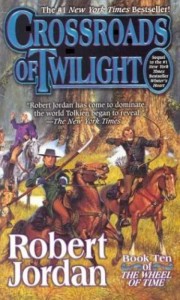 My advice: Read the first book and watch the movie. Don’t bother with the rest, which betrays the characters created in the first book and is driven by a message as subtle as a bludgeon. If you’re a parent pre-screening books for your kids to read, do not judge on the first book alone. At the very least, get a summary of the rest of the series. This is especially true if religious beliefs are important to you.
My advice: Read the first book and watch the movie. Don’t bother with the rest, which betrays the characters created in the first book and is driven by a message as subtle as a bludgeon. If you’re a parent pre-screening books for your kids to read, do not judge on the first book alone. At the very least, get a summary of the rest of the series. This is especially true if religious beliefs are important to you.
His Dark Materials is a trilogy of fantasy novels written by Phillip Pullman comprised of The Northern Lights (known as The Golden Compass in the US), The Subtle Knife, and The Amber Spyglass. The first book of the series was adapted to a movie in 2007.
The series first came to my attention when The Golden Compass movie came out. The previews looked interesting enough, but what really grabbed my attention was the religious groups protesting what they saw as an open attack against organized religion, and especially the portrayal of this within a movie that’s being marketed to children.
As an avid fantasy reader, I’m used to this sort of reaction from certain groups, and usually these reactions seem to be based on the assumption that magic is inherently evil, and so a plot that portrays the side of good using magic is somehow blasphemous. The Harry Potter series is the most memorable such example. I’ve read that series and have not found a single thing in it that I see as damaging or offensive to religion in any way, so I expected His Dark Materials to be the same way.
So first I went to The Golden Compass movie.
The Golden Compass movie
The movie primarily concerns 11-year old Lyra Balacqua and her daemon Pantalaimon (Pan for short). Now, “daemon” in this context has nothing to do with evil creatures of the underworld. The story takes place in a world parallel to ours where every person has a daemon. The daemon is the physical manifestation of each person’s soul. Instead of residing within the body, it exists as an independently thinking animal familiar which can never venture far from its human. For each adult, their daemon’s form resembles their own personality. So a guard might have a dog daemon, someone stubborn might have a badger, and so on. Children’s daemon’s are ever-changing, able to take a variety of forms at will, due to the fact that the child is not yet the adult they will become–so Pan’s shape is ever-shifting to whatever is most convenient at the time. This idea of the daemon souls is one of the coolest things about the series.
Lyra has grown up an orphan raised by Jordan College in Oxford. She eavesdrops on a conversation with Lord Azrael (Daniel Craig) talking to the Magisterium (the church that controls much of the known world), discussing an expedition to the north related to Dust. Dust is a secret well kept by the Magisterium, one of their many secrets.  Soon after that she is placed in the custody of Mrs. Coulter (Nicole Kidman) which seems to be a blessing, but events soon take a turn for the worse. Along the way she meets Iorek (voiced by Ian McKellan), an ice bear, one of a race of sentient armored bears and Lee Scoresby (Sam Elliot) a Texan aeronaut.
The movie is well worth watching. The visuals are stunning and do a good job capturing the cool idea of the daemon familiars. The stars in the cast, while offering poster appeal, do not rest on their laurels. Each of them plays their part well, convincing me of the people they’re portraying. And it’s mostly faithful to the book, which is a rarity. Most of what is changed is that the book ends after revealing one more major plot point than the book (more on that in the spoiler section).
But throughout the whole movie, I didn’t see a single thing as objectionable. The church of this world plays a major villainous role but even in our world, regardless of what you think of modern religion, past religions have done some terrible things in the name of their god. To portray one religion as villainous, especially a fictional religion, does not imply an overall anti-religion message. After watching the movie, my only guess was simply the fact that the word “daemon” was used to represent the soul.
His Dark Materials trilogy of novels
My interest still piqued, I picked up the books. As I said the movie was mostly faithful to the first book. I enjoyed the writing style, the characters were rich and interesting, the descriptions were fun, the worldbuilding was superb, and still no anti-religious undertones that I could detect.
But starting with the second book, The Subtle Knife, the anti-religion message began to coalesce even as the quality of the story declined. The third book, The Amber Spyglass, has an anti-religion message as subtle as a club with nails in, which I might’ve been able to overlook with great effort except that the story was weak as well, serving only to provide the framework with which to hang the message. Major characters constantly take a 180 degree turn in traits without any warning or provocation, even including our protagonist, Lyra! They spend embark on quests with no clear goal and much of the time is spent with secondary characters in other worlds that end up having no appreciable effect on anything! More details after the spoiler warning just below.
Now, finally, the reasons why I hated the series (other than the first book):
1. Story vs. Message– I often like a story that carries messages inherent in it, but the writing has to be a story, first and foremost. But I don’t like tales where the message carries the story, or in this case, robs and leaves the story bleeding and half-dead by the side of the road. Pullman is capable of writing a really great story, as evidenced by book 1, but the quality of the story steadily declined as the strength of the message increased.
2. Betraying Characters– Not only does Pullman disrespect his readers, but disrespects his own creations by destroying the characters he took so much time characterizing in the first book. Nearly every major character makes a 180 turn in character traits without inciting incident or really for any reason whatsoever. I want to find out what happened to the real Lyra, not the doppelganger that takes her place for most of the series!
3. The Grand Con–But above all, Pullman’s plot is structured to fly under the radar of concerned parents. If a parent reads the first book of the series and sees no objectionable material, they may decide it’s okay for their kids to read. Above all, my main objection is not that I hate the message, it’s the fact that the story is structured to conceal the message for so long. The message is clearly anti-religion, and I can totally understand why parents with strong religious beliefs would not want their kids reading it. He’s pulled off the oldest con in the book–the bait and switch. My advice: concerned parents should at least read a synopsis of the series before deciding if it’s objectionable–do not judge based on book 1 alone. For this reason, I think that the religious groups’ protests are completely merited in this case, and serve as a warning to parents who would otherwise have been duped by Pullman.
I’ve heard that Pullman intended His Dark Materials to counterbalance C.S. Lewis’s Chronicles of Narnia. Narnia is well-known for it’s religious allegory, particularly the Aslan to Jesus comparison with the self-sacrifice and resurrection themes. Pullman hates Narnia, and more power to him: he can dislike whatever books he wishes to. But, regardless if you agree with Lewis’s religious message or not, he was upfront about it. The religious themes are present in the first book, so any parent who didn’t want their children to read religious themes could easily see that and just set the book aside. Lewis’s story carried a message, but he managed to do so without having to resort to the bait and switch. Also, Lewis’s stories stay true to their characters and carry their message much more seamlessly than Pullman has managed. I can read Lewis’s stories and just enjoy the stories.
Begin Spoilers!
And, for those of you who don’t mind knowing the plot details, I’ll now give details to back up my claims.
As the series go on we learn that Lord Asrael plans to kill God. That alone doesn’t make the series anti-religious, of course. The character is not the author, and at the end of book one it becomes very clear that Asrael is a psychopath, bent on reaching his own goals regardless of who he hurts along the way. I hesitate to use the word “evil”, but he is representative of some of the worst parts of humanity: selfish, greedy, void of compassion. Where this storyline does become anti-religious is the portrayal of God. He is no creator, merely the oldest surviving angel who has succeeded in duping everyone into believing he is all-powerful and the maker of everything. And even angels are nothing particularly special. They are merely a species that happens to look rather human-like, and have very long lifespans, but otherwise are like humans in every way. God, in the story, has gone completely senile. He is a drooling idiot without any clue what’s going on around. He is merely a figurehead, a puppet in the hands of the Metatron. And, shortly after he’s shown, God dies. Not only that, but the death scene is so unremarkably, remorselessly written that it may have well have been a description of someone eating breakfast.
Another message that I absolutely hated was the lessons learned in the afterlife. In the second book, a knife is introduced which can slice gateways between worlds. In the third book, they decide to go to the land of the dead, which is reachable through this sort of gateway. Why they want to go there is never adequately explained, but it somehow becomes a major goal, and they pursuit it with great ambition and no point. Every soul goes to the same afterlife, a lightless place where everyone is tortured by harpies. Why this should be is never explained, this is just how it works. Lyra’s grand solution is to cut a hole into another world and strike a bargain with the harpies. When souls pass through the portal they dissolve into nothingness. The harpies gain nourishment from hearing stories, so they will let souls pass through the gateway if they have stories to tell. This is where one of Pullman’s grand morals comes from: Live your life with curiosity, ask questions, learn, so that your grand reward will be nothingness. If you live any other way, then you will suffer through eternal torture. I enjoy contemplation of the afterlife, but to determine placement in heaven or hell by such an arbitrary concept is very annoying to me. I’m a curious person who enjoys many sorts of learning, but I don’t think that incuriousity should condemn you to hell. It seemed to me this was just his further condemnation of religion. If you rely on faith for your beliefs then you deserve such a fate, he is saying. That is just as bad as religious groups claiming that non-believers will be condemned to hell for their lack of belief–odd that someone who so readily condemns fate is the creator of such an illogical theological system.
One element that Pullman apparently meant to use for shock value is the presence of homosexual angels. I’m not objecting about the presence of homosexuals or homosexual angels. Historically, I think that angels are generally considered to be devoid of sexual organs or even gender differences, so the idea of them being homosexual is a little bit silly, but whatever. What bothers me about these characters is they have no other distinguishing characteristics other than their homosexuality, as if being gay is the only trait they have that is worth mentioning. I wish he’d taken the time to flesh them out a little bit more so that I could believe that he really meant them to be real people in his world, not just token gay characters who are present only to get a rise out of the more vocal religious groups.
As for how he betrays the characters: worst of all is how he treats Lyra throughout. She very well characterized in the first book, charismatic, a constant liar but not an immoral person. She’s very strong-willed and always willing to fight for what’s right, no matter the risk. The biggest change between the movie and the first book is that the movie truncates one huge plot element. At the end of the book, Lyra sets out to rescue Lord Asriel from captivity. That’s where the movie ends, but in the book she finds him, and he rewards her by kidnapping her best friend, carrying him away and forcibly separating him from his daemon. He’s discovered that the bond between a human and their daemon holds massive amounts of energy. By severing the link, the energy is released all at once. He harnesses the energy to open a portal to another world, remorselessly leaving her friend a shattered husk of a human being. This lowers my opinion of Lord Asriel’s character to a point that he can never be redeemed from, and especially since Lyra’s best friend was the victim, I would expect her to do the same. She’s mad at first, but as the books go on, she has more and more sympathy for Asriel, and seems to have completely forgotten what he’s done. This is never resolved in any way that makes sense for her character. Her feelings simply dissolve as if nothing had ever happened.
Worse than that, is the price she pays to get into the underworld. She is told that she cannot take her daemon with her into the underworld, when she boards the raft that will carry her into the underworld. After a shockingly short time of deliberation, she agrees. There’s no apparent reason that he couldn’t turn into a bird and follow along behind, but this doesn’t happen. Once the distant is too great, the bond breaks, and they are separated. This is her SOUL, for the love of Pete. And, in this world, the sould is a separate mind, so she is causing torture to this other individual for no reason. And remember, she had no reason to go to the underworld in the first place! I lost all respect for her at that point, and never regained it.
The end result is that I wasted weeks of reading time finishing these, and wish I’d read something else instead. But I hope this review will make the time somewhat worthwhile to share the information with others.







